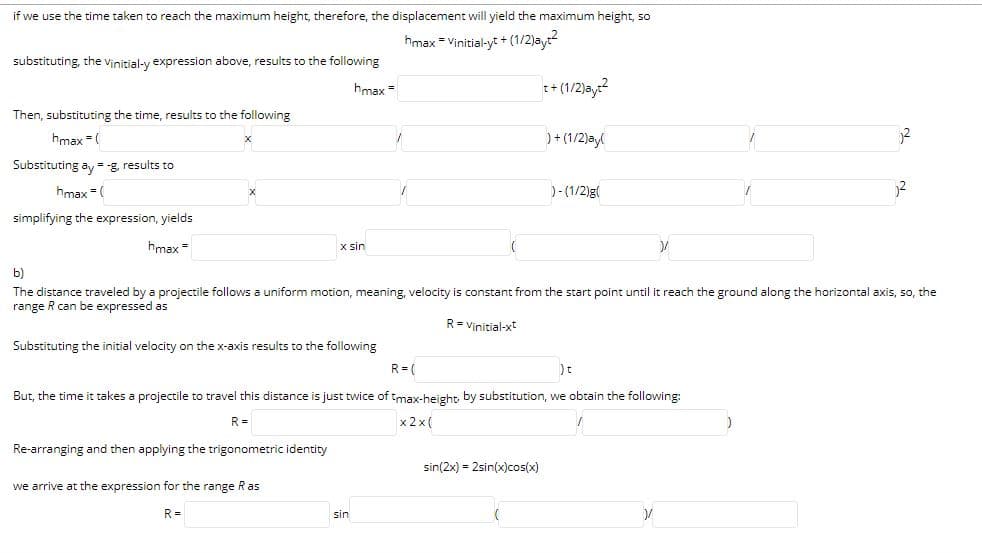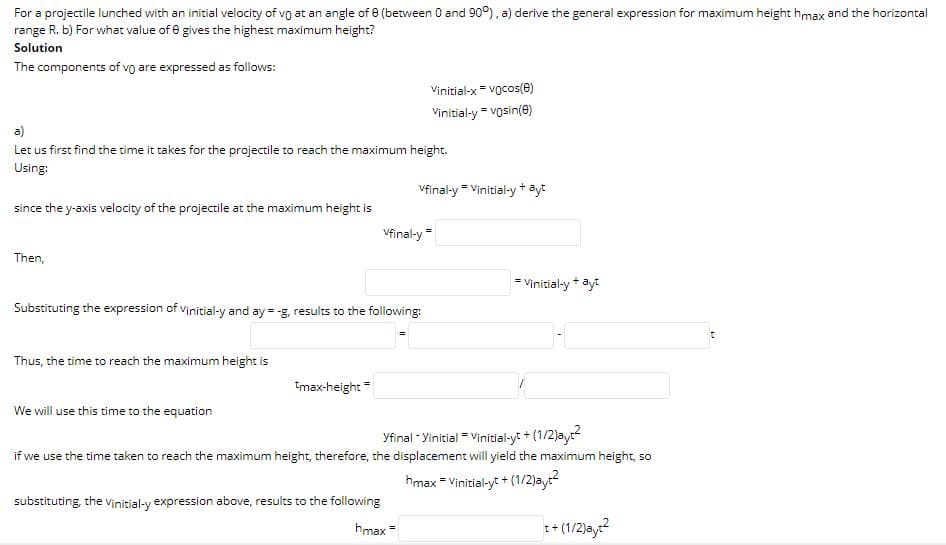For a projectile lunched with an initial velocity of v0 at an angle of θ (between 0 and 90o) , a) derive the general expression for maximum height hmax and the horizontal range R. b) For what value of θ gives the highest maximum height?
For a projectile lunched with an initial velocity of v0 at an angle of θ (between 0 and 90o) , a) derive the general expression for maximum height hmax and the horizontal range R. b) For what value of θ gives the highest maximum height?
Related questions
Question
For a projectile lunched with an initial velocity of v0 at an angle of θ (between 0 and 90o) , a) derive the general expression for maximum height hmax and the horizontal range R. b) For what value of θ gives the highest maximum height?
Please see images for full problem.

Transcribed Image Text:if we use the time taken to reach the maximum height, therefore, the displacement will yield the maximum height, so
hmax = Vinitial-yt + (1/2)ay
substituting, the vinitial-y expression above, results to the following
hmax =
t+ (1/2)ay?
Then, substituting the time, results to the following
hmax =(
)+ (1/2)ayl
Substituting ay = -g, results to
hmax = (
)-(1/2)g
simplifying the expression, yields
hmax =
x sin
b)
The distance traveled by a projectile follows a uniform motion, meaning, velocity is constant from the start point until it reach the ground along the horizontal axis, so, the
range R can be expressed as
R= Vinitial-xt
Substituting the initial velocity on the x-axis results to the following
R= (
But, the time it takes a projectile to travel this distance is just twice of tmax-height by substitution, we obtain the following:
R =
x 2 x (
Re-arranging and then applying the trigonometric identity
sin(2x) = 2sin(x)cos(x)
we arrive at the expression for the range Ras
R =
sin

Transcribed Image Text:For a projectile lunched with an initial velocity of vo at an angle of e (between 0 and 90°), a) derive the general expression for maximum height hmax and the horizontal
range R. b) For what value of e gives the highest maximum height?
Solution
The components of vo are expressed as follows:
Vinitial-x = vocos(e)
Vinitial-y = vosin(e)
a)
Let us first find the time it takes for the projectile to reach the maximum height.
Using:
Vfinal-y = Vinitial-y + ayt
since the y-axis velocity of the projectile at the maximum height is
Vfinal-y
Then,
= Vinitial-y + ayt
Substituting the expression of vinitial-y and ay = -g, results to the following:
Thus, the time to reach the maximum height is
tmax-height =
We will use this time to the equation
Yfinal - Yinitial Vinitial-yt + (1/2)ay
if we use the time taken to reach the maximum height, therefore, the displacement will yield the maximum height, so
hmax = Vinitial-yt + (1/2)ay?
substituting, the Vinitial-y expression above, results to the following
hmax =
++(1/2)ay?
Expert Solution
This question has been solved!
Explore an expertly crafted, step-by-step solution for a thorough understanding of key concepts.
Step by step
Solved in 6 steps with 17 images
